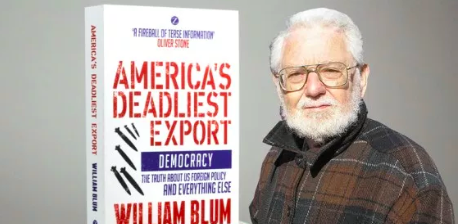When I first started reporting on the CIA in the 1980s, I learned early on Bill Blum was a good source for stories. He wrote for Covert Action Information Bulletin (later Covert Action), a notorious publication in Reagan’s Washington. The CAIB that had the feel of samizdat, the underground publications of dissidents in the Soviet Union. It was illicit. It didn’t circulate widely. Yet it contained truths the government did not want to admit.
Blum was controversial. He worked with renegade CIA agent Phillip Agee who exposed the agency’s operations in Latin America, and was regarded by some as a traitor. Blum was notorious, not because the things he wrote about the CIA were untrue, but because they were all too true.
My fellow Washington journalists disdained the likes of Agee and Blum because they broke the laws about the handling of secret information. But, of course, the CIA was breaking the laws of country’s like Chile where Blum lived in the early 1970s. He saw the reality of the agency’s operations against the leftist government of Salvatore Allende. The CIA’s “destabilization” campaign culminated in the 1973 military coup that imposed dictatorship on a country that had long been democratic. I liked Blum because he wasn’t morally neutral about the agency’s “successes.”
As I started reporting on the CIA involvement in the civil wars of Central America for the New Republic and The Nation, I turned to Blum’s for leads. His articles on agency operations were impassioned but factual, studded with officer’s names and aliases, code names, and other operations they had mounted.
Death Squads
One example: Thanks to Blum I came to understand how the U.S. government created and funded the right-wing death squads of El Salvador. I read in Covert Action Information Bulletin about Roberto D’Aubuisson, the assassin-in-chief of a network that the UN later found had killed more than 900 people. D’Aubuisson had been trained at the International Police Academy, a CIA training outfit based in northern Virginia. Blum thought that was a story worth reporting. I was inspired by that.
In 1992, the United Nations Truth Commission affirmed Blum’s reporting. D’Aubuisson had personally ordered the assassination of Monsignor Oscar Romero, now canonized by the Vatican for his courageous defense of the poor people of El Salvador. D’Aubuisson had run his death squad with the help of the intelligence section of the Salvadoran armed forces, according to the Commisson’s report.
With Blum’s help, I came to understand the CIA not only as a menace but also a bureaucracy with a history. His knowledge of covert action operations was vast. His book, Killing Hope: U.S. Military and CIA Interventions Since World War II, was called, by Noam Chomsky, “far and away the best book on the topic.”
Blum understood a fundamental reality of American political culture. Toward the end of his life he said.
“Consciously or unconsciously, [the American people] have certain basic beliefs about the United States and its foreign policy…The most basic of these basic beliefs, I think, is a deeply-held conviction that no matter what the US does abroad, no matter how bad it may look, no matter what horror may result, the government of the United States means well.”
This is the mindset that confronts anyone and everyone who wants to hold the CIA accountable. Blum knew what he was up against, and he still fought the good fight. RIP Bill Blum.
Source: William Blum, Renowned U.S. Foreign Policy Critic, Dead at 85 – CovertAction Magazine



